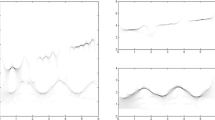Summary
The application of Singular Value Decomposition (SVD)to analysis of EEG and evoked potential data has led to a hypothesis concerning the underlying structure of the EEG recorded from multiple channels. Based on the SVD algorithm the EEG is considered to be the linear combination of a sufficient number of features, each of which is defined in terms of its spatial distribution, temporal distribution, and amplitude. Use of this model leads to clear concepts concerning sampling, data reduction, normalization, and calculation of statistical significance, some of which are less evident when analysis is restricted to a single domain of interest.
Similar content being viewed by others
References
Burch, N. E., Nettleton, Jr., W.J., Sweeney, J. and Edwards, R.J. Period analysis of he electroencephalogram on a generalpurpose digital computer, Ann. N.Y. Acad. Sci., 1964, 115: 827–843.
Duffy, F.H., Burchfiel, J.L. and Lombroso, C.T. Brain electrical activity mapping (BEAM): a new method for extending the clinical utility of EEG and evoked potential data. Ann. Neurol., 1979, 5: 309–321.
Gasser, T., Mocks, J. and Bacher, P. Topographic factor analysis of the EEG with applications to development and to mental retardation. Electroencephal. Clin. Neurophysiol., 1983, 55: 445–463.
Golub, G. H. and Kahan, W. Calculating the singular values and pseudo-inverse of a matrix. SIAM J. Num. Anal., 1965, Ser. B 2, 205–24.
Golub, G.H. and Van Loan, C. F. Matrix Computations. Baltimore, Johns Hopkins Press, 1983, 476.
Grass, A. M. and Gibbs, F. A. A Fourier transform of the electroencephalogram. J. Neurophysiol., 1938, 1: 521–526.
Harner, R. N. Computer analysis and clinical EEG interpretation— perspective and application. In: Dolce, G and Künkel, H. (Eds.), Computerized EEG Analysis, Gustav Fischer, Stuttgart, 1975, 337–343.
Harner, R. N. Topographic analysis of Multichannel EEG data analysis. In: D. Samson-Dollfus, et al. (Eds.) Statistics and Topography in Quantitative EEG. Paris, Elsevier, 1988, 49–61.
Harner, R.N. and Ostergren, K.O. Computed EEG Topography. Electroenceph. Clin. Neurophysiol., 1978a, (Suppl.), 34:151–61.
Harner, R.N. and Ostergren, K.O. Computed EEG Topography: a new method for the study of neurological disorders. Trans. Am. Neurol. Assoc., 1978b, 103:127–9.
Harner, R.N. and Riggio, S. Application of singular value decomposition to topographic analysis of flash-evoked potentials. Brain Topography, 1989, 2: 91–98.
Hotelling, H. Analysis of a complex of statistical variables into principal components. J. Educ. Psychol, 1933, 24: 417–441.
Lehmann, D. Principles of spatial analysis. In: Rémond, A. and Gevins, A.S. (Eds.), Methods of Analysis of brain electrical and magnetic signals, rev. ser. Vol. 1 in Handbook of Electroencephalography and Clinical Neurophysiology, Elsevier, Amsterdam, 1987, 309–354.
John, E.R., Ruchkin, D.S. and Villegas, J. Experimental background: signal analysis and behavioral correlates of evoked potential configuration in cats. Ann. N. Y. Acad. Sci., 1964, 112: 362–420.
Pearson, K. On lines and planes of closest fit to systems of points in space. Phil. Mag., 1901, 559–572.
Rémond, A. and Gevins, A.S. (Eds.) Methods of Analysis of brain electrical and magnetic signals, rev. ser. Vol. 1 in Handbook of Electroencephalography and Clinical Neurophysiology, Elsevier, Amsterdam, 1987, 683.
Skrandies, W. and Lehmann, D. Spatial principal components of multichannel maps evoked by lateral visual half-field stimuli. Electroenceph. clin. Neurophysiol., 1982, 54: 662–7.
Ueno, S., Matsuoka, S., Mizoguchi, T., Nagashima, M. and Cheng C. Topographic computer display of abnormal EEG activities in patients with CNS diseases. Mem. Fac. Engng. (Kyushu Univ.), 1975, 34: 195–209.
Author information
Authors and Affiliations
Rights and permissions
About this article
Cite this article
Harner, R.N. Singular Value Decomposition—A general linear model for analysis of multivariate structure in the electroencephalogram. Brain Topogr 3, 43–47 (1990). https://doi.org/10.1007/BF01128860
Accepted:
Issue Date:
DOI: https://doi.org/10.1007/BF01128860




